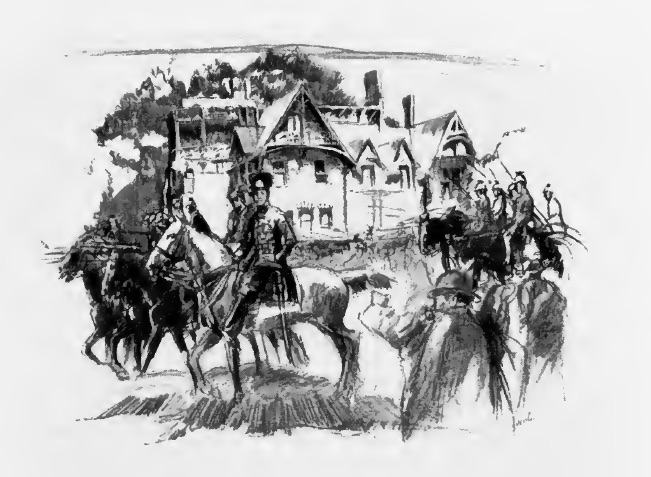By Walter W. Woodward
(c) Connecticut Explored, Spring 2017

“The Crown Prince occupies the Mark Twain House,” illustration from “The Conquest of America,” Charles Moffett, 1916
On June 4, 1921, a German army of 150,000 troops under General von Kluck invaded Connecticut, quickly establishing a line from Bridgeport to Danbury to the town of Washington. Its target was the state’s vast industrial resources and arms manufactories. New York City had capitulated 10 days before; a vastly outnumbered American force of 30,000 men under General Wood had raced south, leaving New England defenseless.
Intent on resistance, defiant crowds gathered in Hartford’s Bushnell Park. The militia of Putnam’s Phalanx and the Governor’s First Company Footguard paraded past the Charter Oak monument as patriotic speeches rang from beside the Nathan Hale statue on Main Street. In New Haven, the Second Company of Governor’s Foot Guards and the New Haven Grays marched past crowds of cheering patriots. But cooler heads prevailed. The Governor, supported by ex-Governor Simeon Baldwin, urged restraint, insisting that to challenge the battle-hardened German troops without an army was futile and doomed to failure.
The Germans occupied New Haven on June 12, and as they had done in New York, took leading citizens as hostages and set up artillery on East Rock overlooking the city. Things were calm until the invaders tried to restart manufacturing at the Winchester arms factory. Then crowds gathered and riots ensued. The Germans fired on the crowds, killing and wounding 200 people. New Haven was pacified.
Kluck’s army moved north, through Wallingford, Meriden, and Middletown. Led by Crown Prince Frederick Wilhelm, the Germans entered Hartford on the morning of June 17. The prince exhibited great knowledge of the city—Colt’s armory, the Pratt & Whitney machine shops, the high educational standards of Hartford High School—and had already arranged to use the Heublein tower for wireless communications between Hartford and the German fleet. The prince also announced that he intended to occupy the former Farmington Avenue home of Mark Twain as his headquarters.
“You know, Mark Twain was a great friend of my father’s,” the Crown Prince said.” I remember how my father laughed, one evening at the palace, when Mark Twain told us the story of the Jumping Frog of Calaveras County.” A row of six-inch German siege guns was set up on the heights at Elizabeth Park, their black muzzles commanding the golden dome of the State House, the belching chimneys of the Underwood Typewriter works, and Trinity College.
The Prince announced in an interview that his forces expected to hold all New England within three weeks. “Within three months we shall hold the entire Atlantic seaboard.” Faced with German arms, he noted, “America must go down to defeat.” . . . .
Twenty-three years before Orson Welles shocked America with the radio drama War of the Worlds about an invasion of America by Martians, Americans were eagerly reading about another invasion of America in the tale partially summarized above. The counterfactual story by Cleveland Moffatt appeared first in serialized form in 1915 in McClure’s Magazine and in an expanded version a year later in the book The Conquest of America: A Romance Disaster and Victory, U.S.A., 1921 A.D., (George A. Doran Company). Moffatt was a former foreign correspondent for The New York Herald turned author and playwright. He wrote his fantasy invasion story to urge an America intent on staying out of World War I that it needed to ramp up its military preparedness, and quickly. He used the methods of the German occupation army in Belgium as a model for his fictional army’s actions in America. He acquired his knowledge of Connecticut while a student at Yale (class of 1883).
Prophetically, while pleading for preparedness, Moffatt also plumped for a focus on airpower. In the story, America is finally saved by a squadron of seaplanes carrying Thomas Edison-perfected torpedoes. “For the first time in history,” Moffatt wrote, “an insignificant air force had conquered a great fleet.” You can read Moffatt’s entire account of our state’s invasion at archive.org/details/conquestofameric00moffiala.
Walt Woodward is the Connecticut state historian. Listen to his podcasts at Grating the Nutmeg and lean about where he is speaking at cthistory.org.
